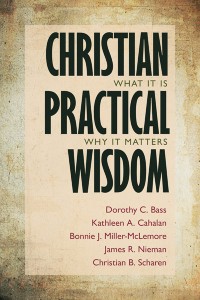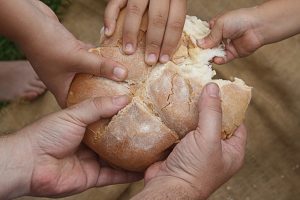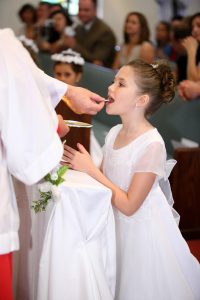 Christian Practical Wisdom: What It Is, Why It Matters
Christian Practical Wisdom: What It Is, Why It Matters
by Dorothy C. Bass, Kathleen A. Cahalan, Bonnie J. Miller-McLemore, James R. Nieman, and Christian B. Scharen
Wm. B. Eerdmans Publishing Co., May 2016, 360 pp.
One of the ways that practical wisdom—or phronesis—has been defined is “doing the right thing, in the right way, at the right time.” In their book, Christian Practical Wisdom: What It Is, Why It Matters, authors Dorothy Bass, Kathleen Cahalan, Bonnie Miller-McLemore, James Nieman, and Christian Scharen explore practical wisdom in a variety of settings, including community life, prayer, family, and pop culture. In this excerpt from the book, author Bonnie Miller-McLemore examines how the different gestures we make when we worship shape our knowledge of God and ourselves, forming us in wisdom. This excerpt was first published in the Spring 2016 issue of Bearings magazine, a semi-annual publication of the Collegeville Institute.
What does it mean to bow to God and to each other as a repeated life-long body practice for these Benedictine monks?
Arriving at the [Saint John’s] Abbey Church a little early, I watch as the monks enter and bow toward the altar where a wooden cross is suspended from the vaulted ceiling—toward God, I suppose. God’s presence seems palpable in the stained glass light and quiet. I do not know what is involved in bowing or what it means for each monk. But I seldom feel so low-church Protestant as when I don’t bow before turning into the wooden pew to lower my seat and find the right page for Morning Prayer. I would feel awkward and insincere bowing. It is not a practice I have learned. It is not bodily familiar to me. I have even incorporated—literally taken into my body, my corporeal repertoire—a modern bias against actions like bowing. But I also feel irreverent and careless not bowing, almost as if I slight God and miss a chance to mark my reverence in movement. I have gained new respect for bowing and I am curious. What does it mean to bow to God and to each other as a repeated life-long body practice for these Benedictine monks?
 This question has preoccupied me because of other worship experiences of late. A few years ago I quit attending the Christian Church (Disciples of Christ) congregation where my membership resides. Sporadically I attend other Disciples churches in Nashville. More regularly I worship in an Episcopalian congregation. I am struck by body habits and postures different from those so familiar to me after a half century of faith formation among Disciples. My bodily sense of disconnect is especially acute during the Eucharist (what Disciples call communion or the Lord’s Supper). What does it mean to process forward and hold out your hands to receive the Eucharist from a priest versus sitting and passing a communion plate, taking bread, and then serving your neighbor?
This question has preoccupied me because of other worship experiences of late. A few years ago I quit attending the Christian Church (Disciples of Christ) congregation where my membership resides. Sporadically I attend other Disciples churches in Nashville. More regularly I worship in an Episcopalian congregation. I am struck by body habits and postures different from those so familiar to me after a half century of faith formation among Disciples. My bodily sense of disconnect is especially acute during the Eucharist (what Disciples call communion or the Lord’s Supper). What does it mean to process forward and hold out your hands to receive the Eucharist from a priest versus sitting and passing a communion plate, taking bread, and then serving your neighbor?
I am sure I am not the first to ask this. I only note it as another powerful instance in which I have felt the body, and knowing theology and God, come into keen play. Even if I wanted to make the Episcopalian congregation my home, compelled by its liturgy, music, preaching, and mission, my body resists, especially at communion or, in this case, Eucharist. I am not sure I will ever entirely overcome a sense that it is not quite right to process forward and exemplify in my body a theology with which I do not entirely agree—that one goes to the altar to receive, one by one, hands outstretched, Christ’s body and blood from a priestly mediator of God’s grace. Occasionally Disciples process forward for communion (free church worship allows for diverse practices). But when we do, the minister or congregant holds out the bread and we tear off a piece; no one places it in our hands.
I see meaning in cupping your hands before another.
Even this tiny difference in bodily action is ripe with meaning. As with bowing, I learn from and appreciate the Episcopalian practice all the more. I see meaning in cupping your hands before another. This posture overflows with potential. With your hands waiting to receive, you could be begging, pleading, hopeful, expectant, dependent, or grateful—each gesture loaded with a host of theological connotations. On more occasions than I anticipate, I am moved (to tears) when the priest or those assisting raise the bread or wine, lock their eyes on mine, and tell me, “the body of Christ, the bread of heaven,” “the blood of Christ, the cup of salvation.” I know I have been given a serious gift, a startling blessing, a physical taste of the intangible. I steal a sideways glance at the half circle of random adults and children around me at the front of the sanctuary, all of us standing together, waiting with empty palms awkwardly turned up as the priest and those assisting start this round of distribution. I see with a little embarrassment what a strange pose we have struck. Rarely do people display their neediness and desire to be filled (loved?) so overtly and patiently.
I make space in my pew one Sunday morning for a woman who tells me after the service how the congregation has become a good place for her husband, a lapsed Catholic, and herself, a Lutheran. I tell her how much I have been drawn myself, finding the church a home for worship, but caught and constrained somehow during Eucharist as someone raised in another tradition. She says she understands. “When my Lutheran mother visited, I had to prepare her.” A little surprised, I ask, “What was so different?” I think of Lutherans as liturgically similar to Episcopalians; they go forward to receive the Eucharist after all. How could this be so disorienting? “We never drink from a common cup in my home congregation,” she responds. “We use individual cups.”
We say and perceive more than we know or understand through our bodies.
That this difference seems disruptive to her and so slight to me reminds me again that I am not alone in finding my faith embedded in the smallest of movements with their multiple, highly elusive, seemingly negligible meanings. Christian faith becomes deeply entangled right here, in these minute body actions and less so in the big conceptual frameworks laboriously worked out over the centuries by church leaders, scholars, and Christian denominations. We say and perceive more than we know or understand through our bodies. This might surprise theological educators who put such stock in our big words and ideas. This doesn’t negate the value of systematic doctrinal reflection. But the devil, so to speak, or the divine, is in the corporeal details.
Our bodies know, our bodies remember, our bodies learn ways to embrace and be embraced by God.
Our bodies know, our bodies remember, our bodies learn ways to embrace and be embraced by God. Bowing and eating are a small part of a whole constellation of habitual actions that make up the life of faith. Are some postures better than others? What do we confess in our small body motions? Do we lose something when we lose certain body postures in a tradition? How do we prevent ritual movements from becoming petty, trivial, or meaningless? When I join the monks for Morning and Evening Prayer, I wonder about bowing, a body movement Disciples do not practice. Monks and other Roman Catholics bow to God when they enter (or to the cross or the consecrated Host? or is it all the same?), when they praise the Trinity during worship, and when they leave. Saturday and Sunday evening, at the start and close of the Sabbath, the monks process in together and bow to the altar and to each other before turning to their seats. What does it mean over a lifetime to bow each time they glorify God? And what about bowing to each other? I notice some monks make eye contact; others do not. Does that matter? Some of the older monks are stooped. Is it from bowing?
Our early encounters of church and faith are remarkably sensate. When religious studies scholar Susan Ridgely Bales studied children’s understanding of first communion in three Roman Catholic congregations in North Carolina, she discovered that what seven-to ten-year-old children believe and experience is not quite what adults or the wider church have in mind. One of the more striking findings from interviews and observations of African American, Anglo, and Latino/a communicants is the impact and centrality of sensory experience. To her surprise, her conversations with children in the weeks leading up to and following first communion did not center on white dresses and parties, much less transubstantiation or joining the Catholic Church universal, but on the “taste of Jesus’ body,” what she calls a “theology of taste.” Taste preoccupies children in the days before first communion and in the hours after it. Six weeks before the service, a nine-year-old expresses a common sense of sensory anticipation: “I can’t wait to taste the bread and wine.” After the service, another nine-year-old remarks, “I just wanted to get the bread; that’s all I wanted to do.” Others make similar comments when asked about the meaning: “You’re eating something very special from a very long time ago;” “You get to eat stuff and you get to come closer to God.” One child even explains her understanding of transubstantiation through taste, saying that the real bread tastes better than the practice bread.
Taste is only one of five senses that shape bodily Christian knowing. It is perhaps the least noticed by scholars, ministers, and adult parishioners. But its power is real. The communion elements matter. A grandson of a colleague told his grandfather one Sunday visit after worship, “your bread tastes better than ours.” My own children moved from a church that broke freshly baked bread each week to one that passed around tiny, tasteless, mass-made wafers. They immediately saw problems with such a reduced sample of divine bounty. “Where’s the bread?” I also see what I would call a theology of sensory movement in Bale’s account. Children yearn for inclusion in the community. They see membership as gained not through “abstract information” but by sharing in the “sensorial knowledge” that members demonstrate. So they are hyper-vigilant about movement. They want to teach “their bodies to move as the adults moved during the liturgy.” They want to “get it right” in front of the congregation.
Are these findings all that unique to children? Adults like to think we are different from children, but in many respects this desire hides important connections and deprives us of childhood wisdom. Most of us do not remember clearly our early sensory experiences, which are reshaped and reinvented through memory and later by experience and learning, but our theology partly resides in body memories nonetheless. When I was in fifth grade I was baptized by immersion. I don’t remember going under or coming up. Try as I might, I can’t picture the minister in the baptistery or recall the temperature of the water, much less details of the baptism classes. But I do remember anticipating what new life would feel like, the weight of the white robe clinging to my body and dragging me back down as I stepped out, wet hair, a group picture, and my pondering whether I felt different. I remain convicted that Christian baptism requires visceral experience that sprinkling can hardly achieve.
Like the children in first communion, adult belief is grounded in sensual experience even though this escapes our notice.
We are naïve when we assume adults leave sensate experience and knowing behind, even though Western doctrinal and intellectual history implies that such detachment from bodies is possible and even admirable, even a sign of intellectual and spiritual maturity (and a mark of true science and morality). In fact, there is something to be learned from children and studies of children. Children of all ages are active rather than passive learners; they make their own interpretations right alongside those offered to them by adult teachers and parents, utilizing “information from all areas of their lives to develop their own understandings.” Adults are not that different. Like the children in first communion, adult belief is grounded in sensual experience even though this escapes our notice. Sensory understandings that formed us as children linger longer than most of us realize and continue to mark our theology and knowledge of God.
Doctrinal debates that have grown up around the interpretation of [the Words of Institution said during communion]… are many and complex. For the moment, I set such arguments aside. I simply want to ask what it means to encounter God through Christ’s body and what our bodies teach us, if anything, in our yearning to know God. Our theology is grounded in our bodies. We have no other way to know God than through our bodies. How do bodies—bodily knowledge—inform, shape, and transform our Christian knowing? Given the main claims of Christianity, we can hardly help but wonder at the aberration of theology as a purely cognitive or intellectual exercise performed at great distance from what actual bodies know or might tell us about faith, theology, or God. There is wisdom in bodily knowing that scholars and ministers have underestimated.
Like this post? Subscribe to have new posts sent to you by email the same day they are posted.




Your article touched my body knowledge. We are enslaved by the uttered word and denied the familiar incarnated word.
Thank you for a timely reflection on the “theology of the body.” Theologians are not the only ones exploring this “corporal epistemology.” Sociologist Pierre Bourdieu makes it a mainstay of his notion of “habitus.” Anthropologists, art historians, and those pursuing interreligious dialogue have also engaged this fascinating topic. For example, here are two noteworthy references: David Morgan, ed. 2010. Religion and Material Culture: The Matter of Belief. London and New York: Routledge; and Young, Andi. 2003. The Sacred Art of Bowing: Preparing to Practice. Woodstock, VT: SkyLight Paths Publishing.